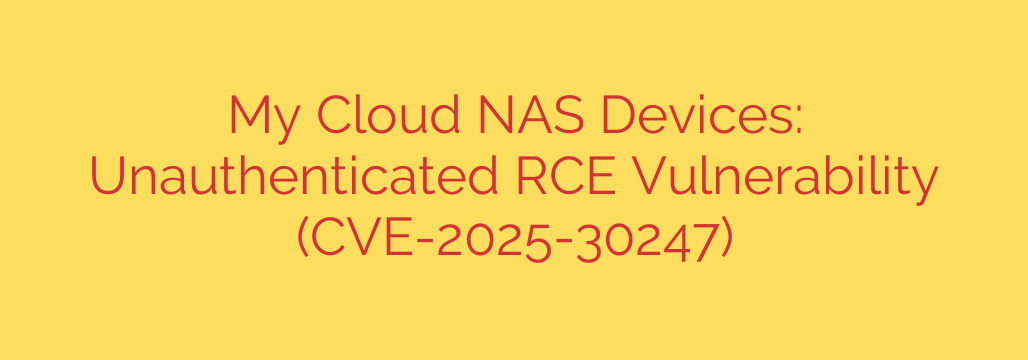
Urgent Security Alert: Critical Vulnerability Found in My Cloud NAS Devices (CVE-2025-30247)
If you use a Western Digital (WD) My Cloud Network Attached Storage (NAS) device to store your personal or business data, it is crucial that you take immediate action. A significant security flaw, identified as CVE-2025-30247, has been discovered that could put your sensitive files at severe risk.
This vulnerability is particularly dangerous because it allows for unauthenticated remote code execution (RCE). Understanding what this means is key to recognizing the threat.
What is the CVE-2025-30247 Vulnerability?
In simple terms, this security hole allows a potential attacker to take control of your My Cloud NAS device over the internet or your local network. The two most critical aspects of this vulnerability are:
- Unauthenticated: The attacker does not need a username or password to exploit the flaw. Your security credentials offer no protection against this specific attack vector, making any vulnerable device a potential target.
- Remote Code Execution (RCE): This is a worst-case scenario in cybersecurity. It means an attacker can run their own malicious commands on your device. This gives them a level of control similar to what you have as the administrator.
Combining these two factors means a remote, unauthorized individual could gain complete administrative control over your storage device, compromising all the data it holds.
The Dangers of an Unauthenticated RCE Vulnerability
Once an attacker gains control of your NAS device, the potential for damage is enormous. They could:
- Steal your data: Access, copy, or delete any file stored on the device, including personal photos, financial records, business documents, and other sensitive information.
- Install ransomware: Encrypt all of your files and demand a ransom payment to restore your access. With control of the device, deploying ransomware is a straightforward process for a malicious actor.
- Use your device in a botnet: Hijack your device’s resources and use it to participate in larger cyberattacks, such as Distributed Denial-of-Service (DDoS) attacks, without your knowledge.
- Attack other devices on your network: Once they have a foothold on your network via the NAS, attackers can attempt to move laterally and compromise other connected devices like computers, cameras, and smart home gadgets.
How to Protect Your My Cloud NAS Device: A Step-by-Step Guide
Protecting your data from this threat requires prompt action. Do not delay in taking the following steps to secure your device and your network.
1. Update Your Firmware Immediately
This is the single most important action you can take. The manufacturer has likely released a security patch to fix this vulnerability.
- Log in to your My Cloud device’s administrative dashboard.
- Navigate to the “Settings” or “Utilities” section.
- Find the “Firmware Update” or “Software Update” option.
- Check for and install the latest available firmware version. Do not ignore update notifications.
2. Disable Remote or Internet Access
If you do not require access to your files from outside your home or office network, disable all remote access features. This feature, often called “Cloud Access” or “Remote Access,” is what exposes your device to the internet. By turning it off, you significantly reduce the attack surface, making it much harder for external attackers to find and exploit your device. You will still be able to access your files from devices connected to the same local network.
3. Ensure Your Device Is Behind a Firewall
Confirm that your internet router’s firewall is enabled and properly configured. You should never connect a NAS device directly to the internet without a firewall. For advanced users, ensure that you are not forwarding unnecessary ports to your My Cloud device and that it is not placed in a “DMZ” (demilitarized zone).
4. Maintain Regular Backups
This vulnerability is a stark reminder of the importance of a robust backup strategy. Even if your device is compromised, having independent backups ensures your data is safe. Follow the 3-2-1 backup rule: keep at least three copies of your data on two different types of media, with one copy stored off-site or in a separate, secure cloud service.
Stay Proactive, Stay Secure
The CVE-2025-30247 vulnerability is a serious threat to the security of your personal and professional data. While the flaw is critical, it is also fixable. By staying informed and taking proactive security measures, you can protect your digital assets.
The most critical step is to update your device’s firmware without delay. Check for a new software version today to ensure your My Cloud NAS is patched, secure, and safe from this dangerous vulnerability.
Source: https://www.helpnetsecurity.com/2025/09/30/western-digital-my-cloud-nas-cve-2025-30247/








